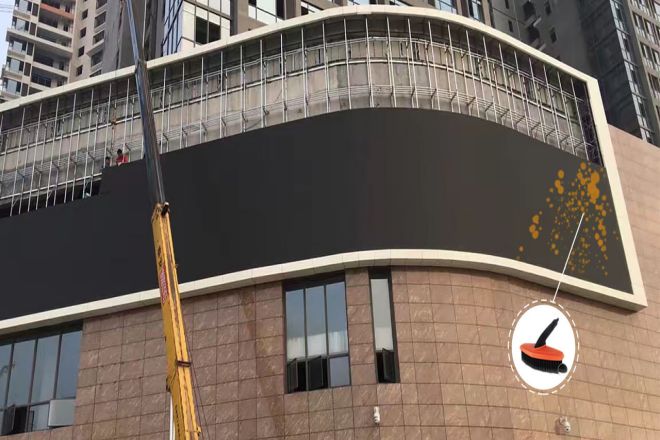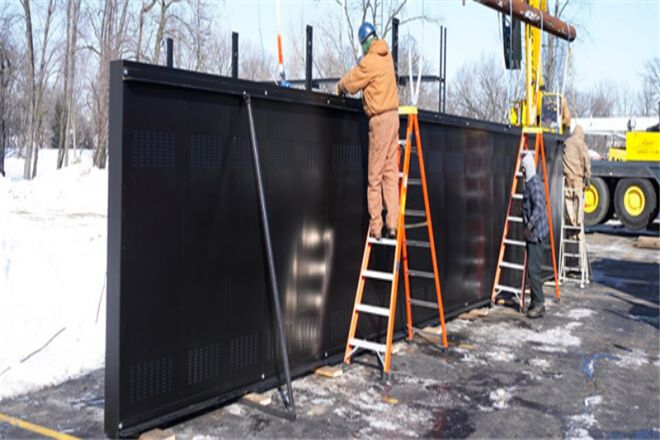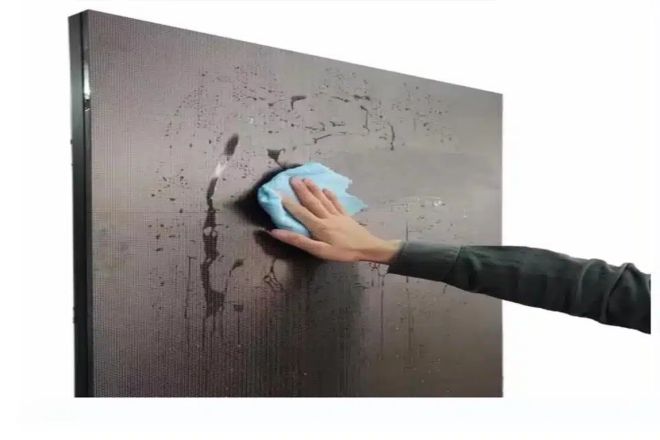Introduction

When we are immersed in the gorgeous visual feast brought by Afficheurs LED, have you ever thought about the maintenance behind it? Cleaning LED displays, this seemingly simple action, actually contains multiple benefits such as improving visual experience, ensuring information transmission efficiency, and extending the life of the equipment.
This article will briefly explain the importance of cleaning LED displays and the benefits they bring so that you can easily master this key maintenance skill while you are busy so that the display continues to shine.
1. Basic knowledge of cleaning LED displays
As an important medium for modern information dissemination, the Cleaning and maintenance of LED display screens are essential to maintaining the display effect and extending the service life. The following is a further detailed explanation and supplement based on the basic knowledge of LED display screen cleaning provided by you:
1). Preparation before Cleaning
1.1). Power off safety
- Complete power off:
Before any cleaning work, you must ensure that the LED display screen has been completely powered off and all related power plugs have been unplugged from the socket.
This is not only a necessary measure to prevent electric shock but also avoids accidentally triggering certain functions of the display screen during the cleaning process, causing unnecessary damage or safety hazards.
- Warning signs:
If conditions permit, warning signs such as “Cleaning, do not power on” can be set around the display screen to prevent others from operating it by mistake.
1.2). Tool preparation
- Soft microfiber cloth:
This cloth is delicate, soft, and not prone to static electricity. It can effectively remove dust and stains while reducing friction damage to the screen.
- Vacuum cleaner (low suction mode):
Used to initially clean larger particles and dust on and around the screen surface, but be careful to use low suction mode to avoid excessive pressure on the screen.
- Specialized cleaner:
If there are stubborn stains on the screen, you may need to use a cleaner. Be sure to choose a non-corrosive, alcohol-free cleaner designed specifically for LED displays to avoid damaging the screen coating or causing color distortion.
1.3). Clean the surrounding environment.
- Remove obstacles:
Clean up debris and dust accumulation around the display to ensure that there is enough space for cleaning work and reduce the possibility of dust falling on the screen again.
- Close doors and windows:
If possible, it is recommended to close doors and windows before cleaning to reduce the entry of external dust and impurities.
2). Cleaning Principles
2.1). Gentle operation
- Avoid scratching with hard objects:
It is strictly forbidden to use hard objects (such as blades, steel balls, etc.) to directly scratch the screen surface to avoid scratching or damaging the screen.
- Light pressure and light wiping:
When using a cloth or detergent to clean, keep your hands steady, press and wipe the screen gently, and avoid excessive force.
2.2). Sequential Cleaning
- From top to bottom, from left to right:
Cleaning in a fixed order can effectively avoid missing areas and ensure consistent cleanliness across the entire screen surface.
- Partition cleaning:
Large LED displays can be divided into several small areas for cleaning one by one to improve work efficiency and cleaning quality.
2.3). Avoid direct contact with liquids.
- Dry cloth first:
In most cases, dry cloth should be used for cleaning first. If detergent is needed, the amount should be controlled as much as possible to ensure that too much detergent does not remain on the screen.
- Dry in time:
If moisture or detergent accidentally penetrates the edge or gap of the screen, it should be wiped dry immediately with a dry cloth to prevent moisture from penetrating into the inside of the screen and causing damage.
2. Specific cleaning steps

For LED displays, a unique electronic display device, the following professional and detailed cleaning steps, and additional suggestions need to be specially formulated to ensure that stains can be effectively removed during the cleaning process and the screen can be fully protected from damage.
1). Preliminary dust removal
Because LED displays are usually large in area and have a sensitive surface, thorough dust removal must be performed before cleaning. Use a vacuum cleaner with a soft brush head to gently sweep across the surface of the screen at the lowest suction force, paying special attention to dust that may accumulate on the edges and corners.
If you don’t have a vacuum cleaner, you can also use an electrostatic dust cloth or microfiber cloth to gently brush away the dust, making sure no scratches are left.
2). Deep cleaning
More professional cleaning methods are required for stubborn stains on LED displays, such as fingerprints and oil stains. Choose cleaners designed for high-end electronic screens such as LEDs.
These cleaners usually do not contain harmful ingredients such as alcohol and ammonia and can gently and effectively remove stains while protecting the screen coating from damage.
When cleaning, spray an appropriate amount of cleaner on the cleaning cloth, and then gently wipe the screen surface in a straight or circular motion, avoiding excessive force or repeated rubbing of the same area.
3). Careful drying
After cleaning, use a clean, dry cloth or paper towel to gently press the screen surface to absorb excess moisture. Due to the complex internal structure of the LED display, residual moisture may penetrate into the interior and cause damage, so it is necessary to ensure that the screen is completely dry.
Place the device in a well-ventilated place to dry naturally, and avoid using heat sources such as hair dryers to accelerate the drying process.
4). Additional suggestions
Nettoyage régulier : According to the use environment and frequency of use, formulate a suitable cleaning plan and regularly clean and maintain the LED display to maintain its optimal visual effect and service life.
Avoid using rough materials: During the cleaning process, rough paper towels, wet wipes, or cleaning cloths with abrasive particles are strictly forbidden to be used to avoid scratching the screen surface.
Fonctionnement hors tension : Before cleaning, be sure to turn off the LED display and disconnect the power supply to prevent electrostatic interference and damage caused by accidental touch of the screen.
Check the protective film: If there is a protective film on the surface of the LED display, its status should be checked regularly. Once the protective film is found to be aging, damaged, or affecting the display effect, it should be replaced with a new protective film in time to protect the screen.
3. Cleaning time
There is no fixed standard or mandatory requirement for the cleaning time of the LED display because it depends on multiple factors, such as the cleanliness of the use environment, the frequency of use of the display, the material and maintenance of the display, etc. However, we can use some general suggestions to guide the arrangement of cleaning time.
1). Regular Cleaning
In order to maintain the best display effect of the LED display and extend its service life, it is recommended to clean it regularly. This “regular” can be weekly, monthly, or quarterly, depending on the actual situation of the display and the use environment. For example, in a dusty or highly polluted environment, more frequent Cleaning may be required.
1.1). Conditions that trigger cleaning
In addition to regular Cleaning, there are some situations that trigger the need for Cleaning:
Obvious stains: When obvious stains, fingerprints, or other dirt appear on the screen, it should be cleaned immediately.
Degraded performance: If the display’s performance, such as brightness, contrast, or color saturation, is significantly reduced, it may be caused by the accumulation of dust and dirt. Cleaning is also required at this time.
Maintenance inspection: When performing regular maintenance inspections on the equipment, you can also clean the display screen.
1.2). Choice of cleaning time
When choosing the cleaning time, make sure that the display screen is not in a working state and has been completely powered off. This not only protects the safety of cleaning personnel and equipment but also avoids accidentally triggering certain functions of the display screen during the cleaning process.
1.3). Flexible adjustment
It should be noted that the cleaning time has not been fixed. In actual operation, it can be flexibly adjusted according to the use of the display screen and environmental conditions. For example, before special occasions (such as important events, exhibitions, etc.), it may be necessary to thoroughly clean and maintain the display screen in advance.
4. Daily care and maintenance

For high-end display devices such as LED display screens, daily care and maintenance are crucial. They are not only related to the display effect and service life of the display screen but also directly affect the user experience and system stability. The following are some key daily care and maintenance measures:
1). Inspection régulière
- Connection cable and power supply inspection:
Regularly check whether all connection cables of the display screen (including power cables, signal cables, etc.) are firmly connected and not loose or damaged. This helps to avoid display problems caused by poor contact or aging of the line.
Check whether the power supply is stable to avoid voltage fluctuations or power failures that may damage the display.
- Cooling system inspection:
The cooling system is a key part of keeping the LED display working properly. Regularly check whether the fan, heat sink, and other components are operating normally, clean the accumulated dust, and ensure good heat dissipation.
- Display effect inspection:
Carefully observe the effect of the display, including brightness, color, clarity, and other aspects. Pay attention to checking whether there are problems such as uneven brightness, color distortion, blurred image, etc., and take timely measures to deal with them.
2). Contrôle environnemental
- Clean and dry:
Keep the environment around the display clean and dry, clean the floor and walls regularly, and avoid dust, water mist and other pollutants from entering the interior of the display. Use protective facilities such as dust covers or dust nets to further reduce dust accumulation.
- Contrôle de la température et de l'humidité :
Control the indoor temperature and humidity within a suitable range to avoid damage to the display in extreme environments. Generally speaking, the suitable operating temperature of LED display screens is 0°C to 40°C, and the relative humidity should be maintained between 30% and 80%.
3). Professional maintenance
- Internal Cleaning:
Perform internal Cleaning regularly, including removing dust, dirt, and other impurities from the inside of the display screen. This requires professional maintenance personnel to use professional cleaning tools and equipment to operate to avoid damage to the display.
- Software upgrade and hardware inspection:
Keep an eye on the software update and upgrade information of the display at any time, and perform upgrade operations in a timely manner to improve the performance and stability of the display. At the same time, regularly inspect and maintain the hardware of the display, including the inspection and replacement of key components such as circuit boards, chips, and drivers.
- Dépannage :
When encountering complex problems or failures, do not disassemble or repair the display by yourself. You should contact professional maintenance personnel in time to ensure that the problem is properly resolved and avoid further damage.
Conclusion
Through the above comprehensive introduction to the Cleaning and maintenance of LED display screens, it is not difficult to see that correct cleaning methods and daily meticulous maintenance play a vital role in extending the life of the display screen and improving the display effect.
Let us start now, put what we have learned into practice, and take good care of each LED display screen. I believe that in the near future, they will continue to illuminate our lives and deliver infinite excitement with a more brilliant and dazzling attitude.
Enfin, si vous souhaitez en savoir plus sur les écrans d'affichage LED, Contactez nous s'il vous plait.
